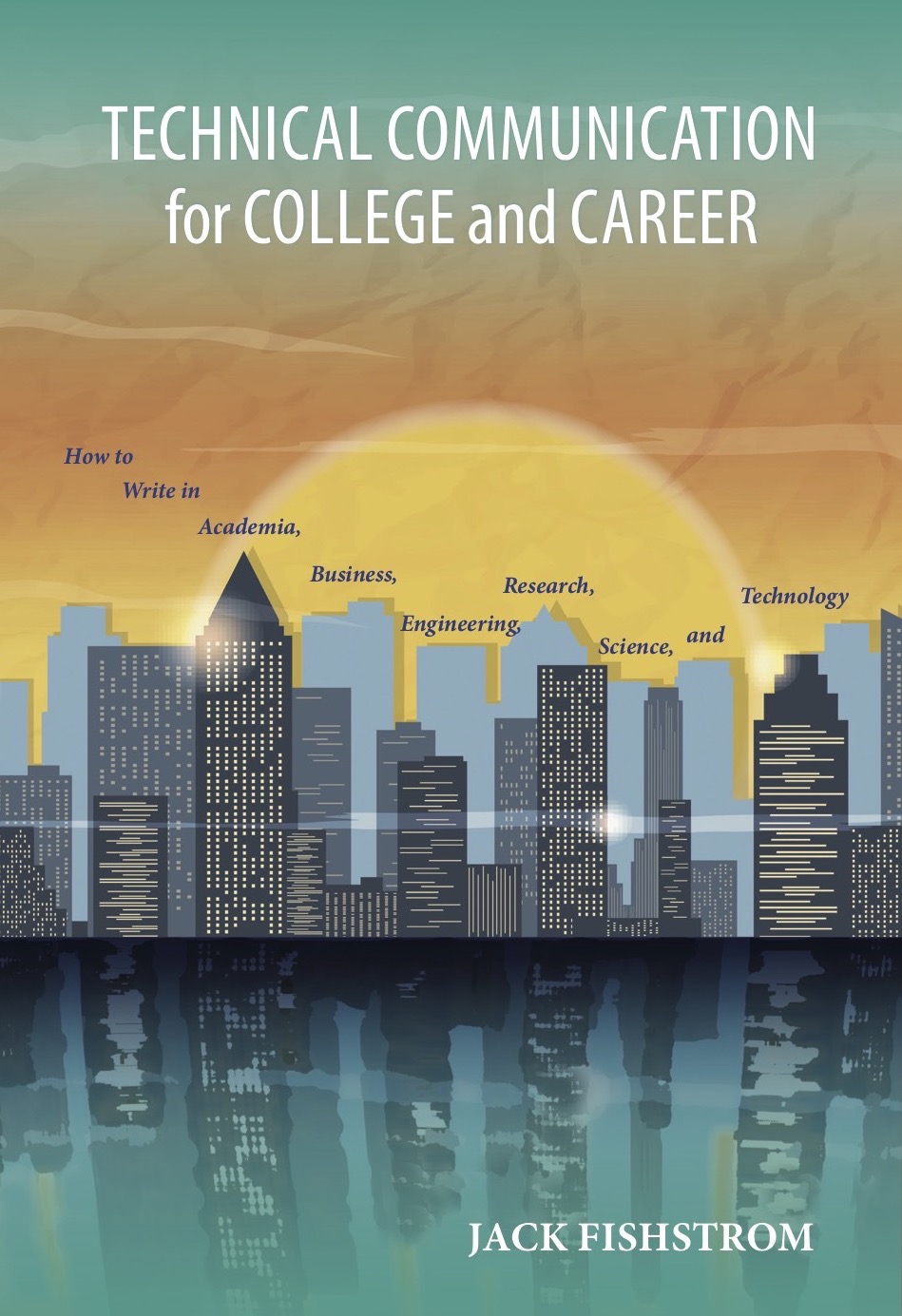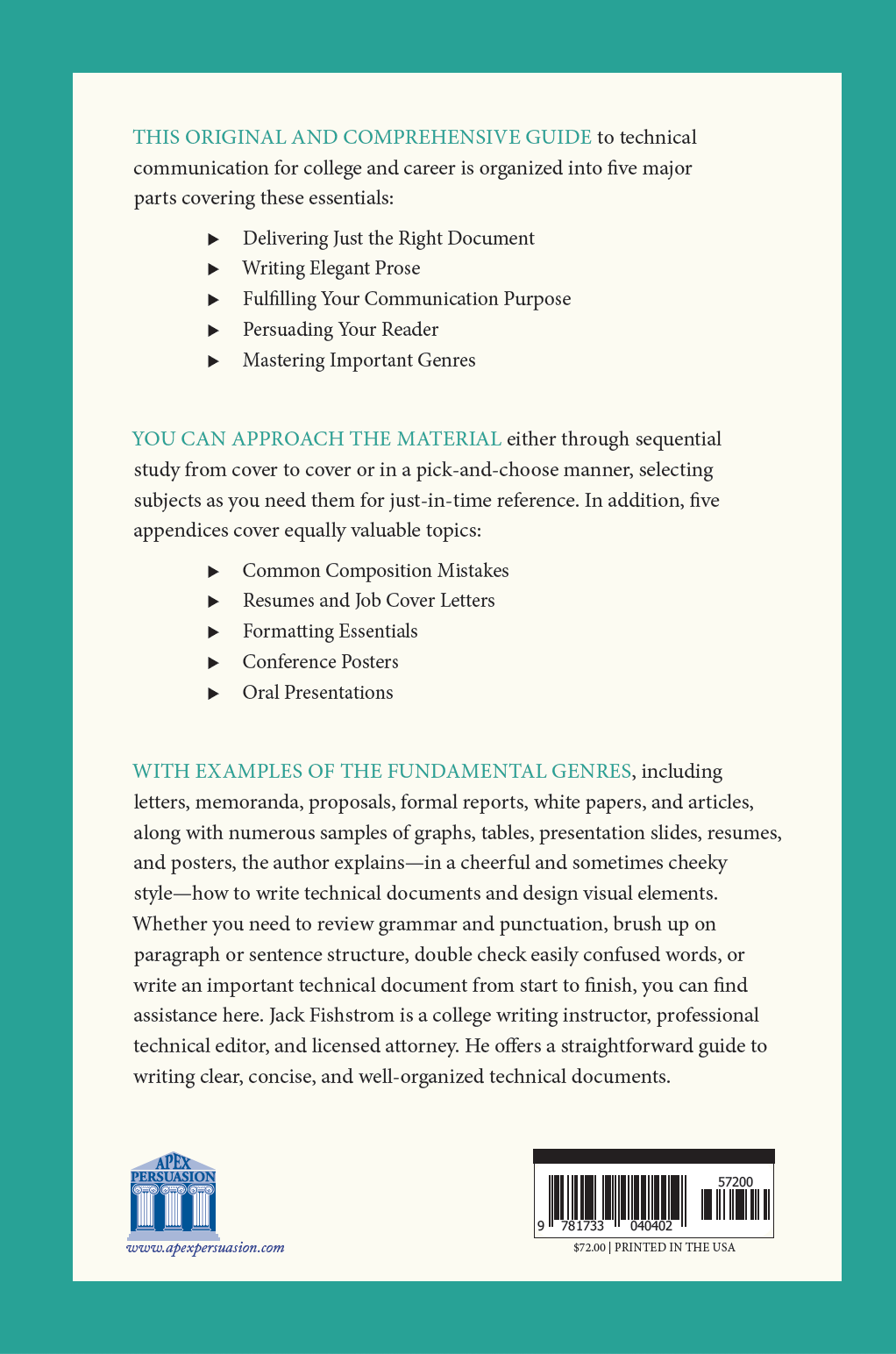
Crafting strategic business and litigation materials &
Providing employee training in business communication ... since 1987




Front cover

Back cover
To use your 50% discount code, enter "genius" in the promotional code box at checkout:
Paperback format
Nook format
Kindle format
Select either soft cover print version or ebook format.
You can also order from these websites
(but discount code is not applicable):
Amazon
Barnes & Noble
This original and comprehensive guide to technical communication for college and career is organized into five major parts covering these essentials:
You can approach the material either through sequential study from cover to cover or in a pick-and-choose manner, selecting subjects as you need them for just-in-time reference. In addition, five appendices cover equally valuable topics:
With examples of the fundamental genres, including letters, memoranda, proposals, formal reports, white papers, and articles, along with numerous samples of graphs, tables, presentation slides, resumes, and posters, the author explains—in a cheerful and sometimes cheeky style—how to write technical documents and design visual elements. Whether you need to review grammar and punctuation, brush up on paragraph or sentence structure, double check easily confused words, or write an important technical document from start to finish, you can find assistance here. Jack Fishstrom is a college writing instructor, professional technical editor, and licensed attorney. He offers a straightforward guide to writing clear, concise, and well-organized technical documents.
Teachers and other important readers want you to follow the assignment requirements,
so reading them, following them, and asking about them as necessary
before you turn in your work is always appreciated.
Typically, a first draft will have lots of “fluff” at the beginning,
which can be excised so that the crucial objectives of a document’s start can be achieved.
The Summary is the place to reveal all the highlights of the report.
Readers must know from the start that they possess a document
that they either need to read or will benefit from reading.
The most beautifully crafted sentences will be of no use if they
are compiled into an inappropriate structure for your writing purpose.
With this structure [for paragraphs], the topic sentence alone
suffices to communicate the point; the following sentences are
merely details that readers can skip without loss of comprehension.
You likely would agree that a tone of expertise is critical at
high levels of management within ABERST. Perhaps less obvious,
however, is that a tone of expertise is needed at ALL levels,
rom the very bottom to the top. No purposeful document can be
delivered within an organization without the author’s having
understood the issues, accomplished some meaningful work with
regard to those issues, and reached some useful conclusion.
The best advice I can give is to avoid both under- and over-use
of the first-person pronouns. Used in the right dosage,
first-person pronouns will improve your ABERST reports.
Basic Acronym Rule: Authors must spell out (define) acronyms the
first time they appear in a document; then it is OK to use the
acronym ever after in that document.
Distinguish between plural and possessive:
Videocassette recorders (VCRs) were popular during the 1980s,
and I collected the 1980’s most popular exercise videos.
In ABERST, you should resist any urge to use exclamation points.
Let the ideas speak for themselves. Trust me on this! Oops!
Purpose Principle: Build each report on a single,
organization-based communication purpose. First, identify the
primary motivating purpose of communicating via an intended
report, and, second, select and organize all necessary
information in support of that purpose.
Professionals will find that reports are no longer simply
assigned to them or demanded of them by others. Certainly,
an external demand is one way a report may originate.
But, equally often, due to the purpose principle, you,
and you alone, may originate a technical report.
The efficient approach is to write one, normalized report that
works for all future audience types.
The various pieces of information in any ABERST report have
different levels of importance.
A rule of thumb for identifying your primary information is this:
it is the information that, if given to your immediate recipient,
would make the recipient believe you have both (1) finished
the project and (2) identified the crucial information
required by the recipient.
An argument is at the core of most technical reports.
Work inductively, but write deductively. In deductive writing,
the author’s conclusion is presented first, right away, and all
the supporting material is delivered second, in an intentional sequence.
Corroboration enhances your argument: by showing that the same
result and conclusion was reached by different methods or persons,
you help make it clear that this is not your own, idiosyncratic,
personal, and subjective finding.
In first drafts of technical reports, a common problem is lack
of flow from one idea to the next. This is solved in various ways.
Linking your communication purpose to the correct genre is vitally
important, as using the wrong genre for an important communication
can lead to confusion: perhaps the intended recipient ignores
the document, or perhaps this person reads only haphazardly
and takes away an incorrect message. For example, if you
want to ask for $10 million dollars in funding, an email
may not be the best genre. You would likely need a formal
proposal. Similarly, a status report is not the genre to
use to communicate a major, unexpected event.
White paper is a fairly generic and empty genre name that can
mean different things to different organizations. The name
itself reveals nothing about the content and format, unlike
“proposal” or “poster.”
If I had to teach just one single genre for ABERST communication,
I would select the memorandum. Although the proposal is perhaps
the most financially crucial, and the journal article perhaps
of the highest profile, the memorandum has the most utility.
It is the workhorse of all documents. It is versatile, and it
is ubiquitous.
Importantly, journal articles are different from most of the
other genres considered in this book because, unlike the others,
they do not have specific recipients who must receive the
information to keep work moving forward. That is, a journal
article is not an effective genre for communicating directly
to another professional or organization on some matter of vital
importance to them. Reading of journal articles is optional,
and you cannot expect that another person will read a journal
article. The purpose with a journal article is to present
information to various persons (mostly unknown) outside one’s
organization to assist and advance the collective state of
knowledge, as well as the author’s prestige, the author’s
organization, and the author’s professional affiliations
(field, discipline, or specialty).
A visual aid should convey its message effectively, honestly,
and autonomously. After that, it needs to do nothing more.
Excessive design flourish, superfluous colors, three-dimensional
portions, and other complex design elements add clutter.
In the worst cases, the clutter leads to ambiguity in the
message and confusion in the reader’s mind. A visual aid
should have just the right elements and nothing more.
This is the quality of simplicity.
Simplicity is an intrinsically good characteristic. But it
yields an additional benefit that can be parlayed into further
advantages. Namely, after clutter and other superfluous elements
are removed, the visual aid has some free space that may be
useful for adding new elements that improve efficacy, honesty,
and autonomy.
Two little words confuse nearly everyone: it’s and its. To
distinguish them, I offer the following definitions and examples
used in a sentence:
It’s—
Definition: a contraction of two words: “it” and “is.”
Sentence example: They wondered if it is possible to run a
marathon under 4 hours.
Its—
Definition: the possessive version for the noun, “it”
Sentence example: The chair felt soft because its seat had been
reupholstered.
Do NOT ever use a comma to separate subject and verb; this is
the dreaded “comma splice.” Here is a double example of incorrect
comma usage: The Chicago Bears, are the best team in football.
The Bears, rule!